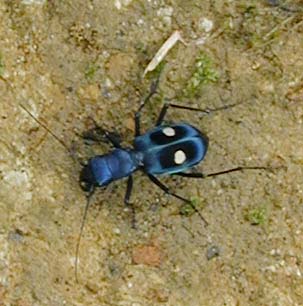
Catching prey is not a simple matter, as potential prey species are under constant pressure to evolve mechanisms to avoid becoming prey items. Predators must stay a step ahead of their prey, in an evolutionary sense, in order to survive. One consequence of this co-evolutionary race is that predators are often endowed with excellent sensory capabilities. Adult tiger beetles (Family Cicindelidae) visually track their insect prey, making short runs which are punctuated by stops that allow them to recalculate prey position and accomodate for prey movement. They quickly zero in on prey location using this process.
Tiger beetle larvae are also predators, but they use a sit and wait strategy, living within burrows in the ground. The larva blocks the burrow with the top of its head and the back of its thorax. When a prey animal comes close, it flips its head backwards, exposing powerful jaws which grab and subdue the prey. As with the adult, visual tracking of the prey is an important component of being a successful predator.
Tigers, Panthera tigris, are an interesting example of active predators, as they quite willingly include humans in their menu. They seem to prefer medium to large prey; a study in India showed that half the diet of tigers in a forest reserve was composed of chital (a spotted Indian deer species), sambar (another common species of deer in India), and wild pigs. Excellent camouflage, stealthy movements, combine with powerful jaws and claws to make this a highly feared predator.
As humans encroach on tiger habitats, the threat of tigers to human life creates a particularly difficult conservation challenge. Conservation plans which include multiple forest uses--usually low-level logging or harvesting of other forest products by humans, may be thwarted by tiger predation on human users of the forest. This creates presssure on conservation officials to remove the tigers from the forest. Modelling tiger/human movement patterns and probabilities of encounters may provide a tool for minimizing these problems.
Not all spiders build webs for catching their prey. Hunting spiders use a variety of strategies, including active search and ambush, to obtain their food. This spider, a common resident of neotropical wet forests, hunts at night, seeking prey in the rich environment of the forest leaf litter.